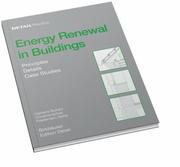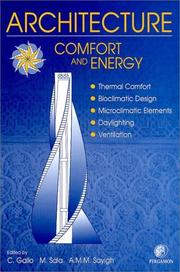| Listing 1 - 10 of 75 | << page >> |
Sort by
|
Book
ISBN: 3030709604 3030709590 Year: 2021 Publisher: Cham, Switzerland : Springer,
Abstract | Keywords | Export | Availability | Bookmark
 Loading...
Loading...Choose an application
- Reference Manager
- EndNote
- RefWorks (Direct export to RefWorks)
Dissertation
Year: 2021 Publisher: Liège Université de Liège (ULiège)
Abstract | Keywords | Export | Availability | Bookmark
 Loading...
Loading...Choose an application
- Reference Manager
- EndNote
- RefWorks (Direct export to RefWorks)
With climate change, the energy consumption of buildings for cooling purposes is expected to rise, further enhancing global warming through the increase of greenhouse gas emissions. To break this vicious circle, it is essential to decrease the anthropogenic CO2 emissions by lessening the energy consumption in all sectors. Buildings are responsible for 40% of energy consumption in the European Union, according to the International Energy Agency (IEA). The urge to build more energy-efficient buildings resulted in the emergence of nearly zero-energy buildings (nZEB). However, the specifications the nZEB design should comply with might not be sufficient to prevent the risk of overheating in summer, hence the purchase of an active cooling system. Passive cooling techniques are investigated through a dynamic simulation of a nearly zero-energy dwelling. Their efficiency is assessed based on their ability to improve thermal comfort while limiting the increase in energy consumption. Thermal comfort is measured based on the theory of adaptative comfort which is the most relevant for a residential building. The passive cooling techniques can be combined to ensure the resilience of the building to global warming. It was found that the most efficient techniques are the ones relying on ventilative cooling. In Western Europe, day cooling should be combined with night cooling to reduce the overheating risk and improve thermal comfort by 39%. Solar protections and smart glazing also offer an efficient protection against overheating. They improve thermal comfort by respectively 34 and 22%. The effectiveness of the combined passive cooling techniques is studied over an extreme meteorological event, which is likely to occur by 2100 if nothing is done to prevent global warming. Twenty days of intense heat are studied to evaluate the resilience of a nZEB. It was found that the most efficient combination includes night cooling, thermochromic glazing and adiabatic cooling. Adiabatic cooling is particularly efficient during heat waves. Those techniques allow to decrease the indoor temperature by almost 10°C. However, occupants’ behaviour could have a negative impact on the cooling techniques efficiency.
Passive cooling --- Global warming --- Nearly zero-energy buildings --- Resilience --- Overheating --- Thermal comfort --- Ingénierie, informatique & technologie > Energie
Book
ISBN: 9789264118492 Year: 2011 Publisher: Paris IEA
Abstract | Keywords | Export | Availability | Bookmark
 Loading...
Loading...Choose an application
- Reference Manager
- EndNote
- RefWorks (Direct export to RefWorks)
Buildings account for almost a third of final energy consumption globally and are an equally important source of CO2 emissions. Currently, both space heating and cooling as well as hot water are estimated to account for roughly half of global energy consumption in buildings. Energy-efficient and low/zero-carbon heating and cooling technologies for buildings have the potential to reduce CO2 emissions by up to 2 gigatonnes (Gt) and save 710 million tonnes oil equivalent (Mtoe) of energy by 2050. Most of these technologies – which include solar thermal, combined heat and power (CHP), heat pumps and thermal energy storage – are commercially available today. The Energy-Efficient Buildings: Heating and Cooling Equipment Roadmap sets out a detailed pathway for the evolution and deployment of the key underlying technologies. It finds that urgent action is required if the building stock of the future is to consume less energy and result in lower CO2 emissions. The roadmap concludes with a set of near-term actions that stakeholders will need to take to achieve the roadmap’s vision.

ISBN: 3038213004 3034614802 9783034614801 1299863833 9781299863835 9783764381219 3764381213 9783038213000 Year: 2007 Publisher: Basel Munich
Abstract | Keywords | Export | Availability | Bookmark
 Loading...
Loading...Choose an application
- Reference Manager
- EndNote
- RefWorks (Direct export to RefWorks)
Mit dem Inkraftreten der der Energie-Einspar-Verordnung EnEV 2006 und der Einführung des Energieausweises für Gebäude innerhalb der EU ist ein starker Anstieg des Auftragsvolumens im Bereich der Gebäudesanierung zu erwarten. Dieser Band ist ein Ratgeber mit konkreten Hinweisen zur Umsetzung energetischer Sanierungsmaßnahmen, der den Planer vom Entwurf bis zur Ausführung begleitet. Alle energetischen Fragen sind entsprechend der Zielsetzungen behandelt. Großmaßstäbliche Detailzeichnungen dokumentieren konstruktive Lösungen zur Behebung baulicher Schwachstellen. Ein Überblick über anlagentechnische Maßnahmen hilft bei der Beurteilung von Möglichkeiten, Kosten und Wirtschaftlichkeit. Dass nachhaltige Verbesserungen nicht allein durch energetische Maßnahmen erreicht werden können, sondern dass die Betrachtung des gesamten Gebäudes wichtig ist, zeigen realisierte Projekte. Die Beispiele sind jeweils mit Zustandsanalyse, Darstellung der Maßnahmen und deren Bewertung dokumentiert. Now that the Energy Certificate for Buildings has been introduced throughout the European Union, we can expect to see a sharp rise in the number of building renovations. This volume is a practical guide with concrete recommendations for realizing energy-related renovation measures - it accompanies the planner from design to execution. All energy-related issues are treated according to their goals. Large-scale detail drawings document constructive solutions for removing structural weaknesses. An overview of installation engineering measures helps to evaluate possibilities, costs, and economic viability. The book uses realized projects to demonstrate that sustainable improvements cannot be achieved by energy-specific measures alone - it is also important to consider the building as a whole. All of the examples are documented with a state analysis as well as a depiction and assessment of the measures taken.
Book
ISBN: 0323995896 9780323995887 0323995888 9780323995894 Year: 2023 Publisher: London San Diego, CA
Abstract | Keywords | Export | Availability | Bookmark
 Loading...
Loading...Choose an application
- Reference Manager
- EndNote
- RefWorks (Direct export to RefWorks)
Building Energy Flexibility and Demand Management looks at the high penetration of intermittent renewable energy sources and the need for increased flexibility. Ensuring electrical power systems adapt to dynamic energy demand and supply conditions, the book supports the transition to a renewable energy future with current fluctuating power generation. By facilitating the penetration of renewable energy sources into the building sector and balancing electricity supply with demand in real-time, this book will provide fundamental concepts, theories, and methods to understand, quantify, design and optimize building energy flexibility. In addition, the book also provides case studies with emerging technologies to enhance building energy flexibility and demonstrate how demand management strategies can utilize energy flexibility for demand reduction and load shifting. It will be useful for all those researchers and engineers working in flexible energy systems and advanced demand side management strategies. --
Book
ISBN: 9783030797423 Year: 2022 Publisher: Cham Springer International Publishing :Imprint: Springer
Abstract | Keywords | Export | Availability | Bookmark
 Loading...
Loading...Choose an application
- Reference Manager
- EndNote
- RefWorks (Direct export to RefWorks)

ISBN: 1281188921 9786611188924 0080560601 9780080560601 9781281188922 008043004X 9780080430041 6611188924 Year: 1998 Publisher: New York ; Amsterdam : Elsevier Science,
Abstract | Keywords | Export | Availability | Bookmark
 Loading...
Loading...Choose an application
- Reference Manager
- EndNote
- RefWorks (Direct export to RefWorks)
In this book we seek to approach the architecture-energy combination and its relationship to human comfort and the environment .There are chapters on thermal comfort, low energy architecture dealing with various criterion for comfort in different parts of the World. The book also seeks to understand how previous generations lived in harsh climates and without abundant sources of energy, yet managed to design and build appropriate dwellings providing both comfort and harmony with the environment. Other chapters deal with the bioclimatic concept in Vernacular Architecture; the major rol
Architecture and climate. --- Architecture and energy conservation. --- Energy conservation and architecture --- Energy efficient buildings --- Energy conservation --- Architecture --- Climate and architecture --- Climatology --- Climatic factors --- Influence of climate --- Zero energy buildings
Book
ISBN: 3035701393 9783035701395 9783038356585 3038356581 Year: 2016 Publisher: Pfaffikon, Switzerland : TTP,
Abstract | Keywords | Export | Availability | Bookmark
 Loading...
Loading...Choose an application
- Reference Manager
- EndNote
- RefWorks (Direct export to RefWorks)
Sustainable construction. --- Construction industry --- Building materials. --- Architecture and energy conservation. --- Energy conservation and architecture --- Energy efficient buildings --- Energy conservation --- Architectural materials --- Architecture --- Building --- Building supplies --- Buildings --- Construction materials --- Structural materials --- Materials --- Green construction --- Sustainable engineering --- Energy conservation. --- Zero energy buildings
Book
ISBN: 9783038267133 3038267139 9783038353294 3038353299 Year: 2015 Publisher: Switzerland : TTP,
Abstract | Keywords | Export | Availability | Bookmark
 Loading...
Loading...Choose an application
- Reference Manager
- EndNote
- RefWorks (Direct export to RefWorks)
The need of today is to have energy efficient buildings materials andconstruction technologies that cater to this rising need. Hence, selectingconstruction and finishing materials that have low embodied energy and haveless operational and maintenance cost is the most powerful tool for thearchitects, designers and the constructors to achieve high energy efficiencyin buildings. This special volume on 'Materials and Technologies for GreenConstruction' contains Ten chapters which address a wide range of issuespertaining to building materials and technologies with reference to energyefficiency. Thi
Sustainable buildings --- Buildings --- Architecture and energy conservation --- Energy conservation and architecture --- Energy efficient buildings --- Energy conservation --- Ecologically sustainable buildings --- Environmentally sustainable buildings --- Green buildings (Green technology) --- Sustainable development --- Zero energy buildings
Book
ISBN: 3030877027 3030877019 Year: 2022 Publisher: Cham, Switzerland : Springer Nature Switzerland AG,
Abstract | Keywords | Export | Availability | Bookmark
 Loading...
Loading...Choose an application
- Reference Manager
- EndNote
- RefWorks (Direct export to RefWorks)
Architecture and energy conservation. --- Buildings --- Sustainable buildings. --- Energy conservation. --- Ecologically sustainable buildings --- Environmentally sustainable buildings --- Green buildings (Green technology) --- Sustainable development --- Energy conservation and architecture --- Energy efficient buildings --- Energy conservation --- Zero energy buildings
| Listing 1 - 10 of 75 | << page >> |
Sort by
|

 Search
Search Feedback
Feedback About
About Help
Help News
News